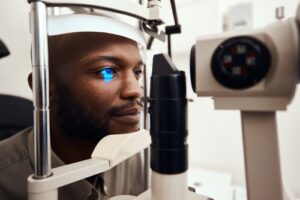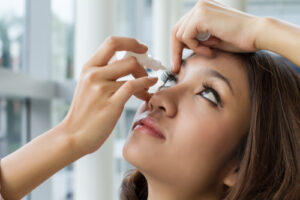Do your eyes feel tired? Are you concerned that you may be experiencing eye strain?
As the world becomes more digital, spending more time on your phone and other devices is normal. This lifestyle has led to an increase in people suffering from eye strain.
If you find yourself experiencing eye strain regularly, it’s essential to schedule an eye exam. Keep reading to discover why it’s time for an eye exam if you’re experiencing eye strain!
What is Eye Strain?

Eye strain, or asthenopia, is a common condition characterized by discomfort or eye fatigue. It occurs when your eyes are overworked.
This is typically due to prolonged use of digital devices, reading, driving, or other activities requiring intense visual focus.
Staring at screens for extended periods without taking breaks is one of the most common causes of eye strain. If you’re not taking breaks while using digital devices or looking at screens, your eyes may develop uncomfortable symptoms like eye strain or fatigue.
How Do I Know if I’m Experiencing Eye Strain?
Knowing and recognizing the signs of eye strain is necessary for diagnosis and treatment. You may have eye strain if you’re experiencing common symptoms like:

- Tired, achy eyes
- Your eyes feel drier or more watery than usual
- You have blurry vision
- You’re having more headaches
- You’re experiencing an increased sensitivity to light
- You’re finding it more challenging to focus
- You find it hard to keep your eyes open
How Will My Eye Doctor Check to See if I Have Eye Strain?
Your ophthalmologist at South Texas Eye Institute will perform several tests and measurements during an eye exam. These tests help determine how healthy your eyes are and can identify any potential issues related to eye strain. These tests may include:
Visual Acuity

Visual acuity is a test that measures how well you can see at different distances. It has you read an eye chart from a certain distance away to determine what you can see clearly.
Refraction Test
A refraction test uses a phoropter with interchangeable lenses of varying powers to determine if you need glasses or an updated prescription.
Ocular Alignment and Muscle Function Tests
These tests assess how your eyes work together and focus by looking at how your eyes align and how muscles in your eyes function.
Pupil Reaction Test
A pupil reaction test evaluates how your pupils respond to light changes.
Retinal Examination
A retinal examination allows your eye doctor to examine your retina. Looking at the retina will enable them to check the back of your eye and its inner workings for abnormalities.
What Repeated Eye Strain Does to Your Eyes
Ignoring eye strain can have long-term consequences on how healthy your eyes are. Frequent and untreated eye strain may lead to:
- Chronic dry eyes
- Progression of nearsightedness
- Computer vision syndrome (CVS)
- Increased risk of age-related eye conditions, such as cataracts and macular degeneration
Can You Treat Eye Strain?

The good news is that eye strain is often temporary and can be treated effectively. Some strategies to alleviate eye strain include:
- Take regular breaks from screen time by utilizing the 20-20-20 rule, which has you look 20 feet away from what you’re doing for 20 seconds every 20 minutes
- Adjusting lighting on your screen to reduce glare and reflections being shone back
- Make sure to position your screen at eye level while maintaining proper posture
- Blinking frequently to keep your eyes lubricated and well-hydrated
- Using artificial tears and eye drops to reduce feelings of dryness
- Following any prescribed treatments from your eye doctor
Lifestyle Changes for Eye Strain Prevention
Besides looking at screens less, you can also change your lifestyle. These changes can significantly reduce the likelihood of eye strain. Try making these habits part of your daily routine:
Outdoor Time
Spending time outdoors, especially in natural light, can reduce the progression of nearsightedness and eye strain. Try taking outdoor breaks to walk and get away from the screens, even if it’s only for five or ten minutes at a time during work or other times you’re usually using screens.
Hydration and Nutrition
Proper hydration and a balanced diet rich in eye-friendly nutrients, such as omega-3 fatty acids, vitamins C and E, and zinc, can help keep your eyes healthy. Remember to drink enough water to stay hydrated and keep dry eyes at bay, and ensure your eyes stay lubricated.
Regular Exercise

Regularly exercising improves blood circulation, which also benefits your eyes. Getting enough circulation to your eyes can help reduce eye strain and promote overall well-being.
Proper Sleep
Getting enough sleep is necessary to ensure your eyes recover from any strain or fatigue from the day. Create a sleep-friendly environment by keeping your bedroom dark and free from electronic devices before bed.
Adjusting Workstation Ergonomics
Many cases of eye strain are associated with poor workstation ergonomics. Ensure your desk and computer setup are ergonomically designed to minimize eye and body strain. Follow these tips for a comfortable workspace:

- Keep your screen about 20-24 inches away from your eyes
- Put your computer monitor at or right below eye level to avoid straining your neck and eyes
- Position your monitor to reduce glare and reflections from windows or overhead lights
- Use an adjustable chair and maintain good posture to prevent neck and back strain.
- Keep frequently used items, like your keyboard and mouse, within easy reach to reduce how much your eyes have to move
Experiencing eye strain should not be ignored, as it can significantly impact your visual health and overall well-being. By scheduling an eye exam and taking proactive steps to manage eye strain, you can ensure your eyes stay healthy and comfortable, even in an increasingly screen-centric world.
Are you concerned about eye strain? Schedule an appointment at South Texas Eye Institute to learn more and help your eyes feel better!

